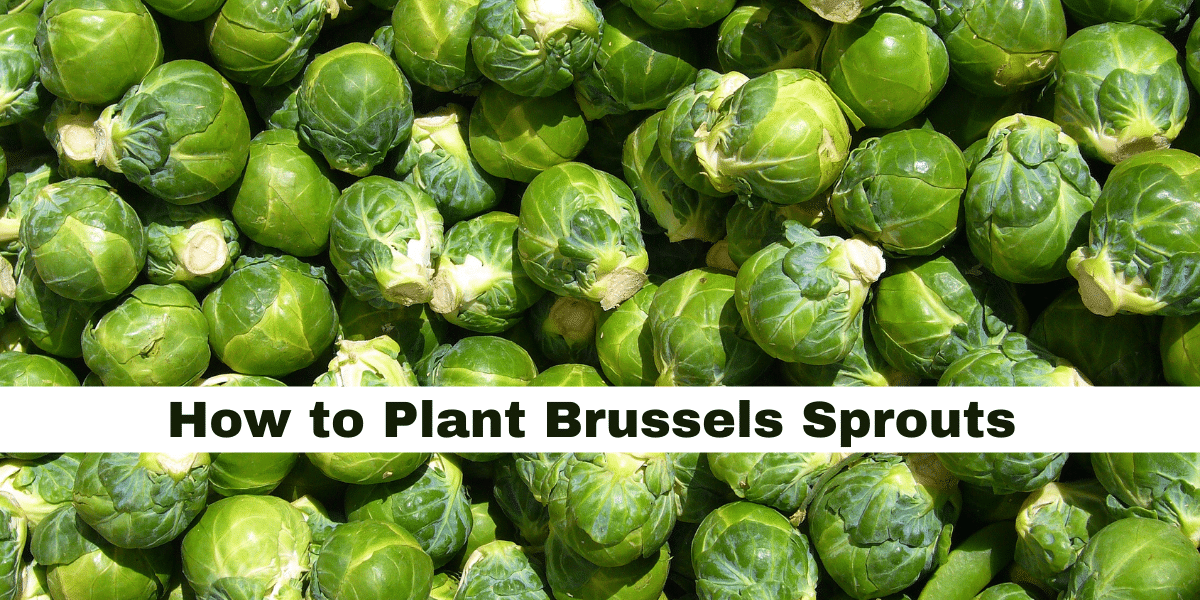How to Plant Brussels Sprouts? The brussels sprout is an individual from the Gemmifera Group of cabbages (Brassica oleracea), developed for its eatable buds. Brussels sprouts are an individual from the Brassicaceae group of vegetables and are firmly identified with kale, cauliflower, and mustard greens.
These cruciferous vegetables take after smaller than ordinary cabbages and are regularly cut, cleaned, and cooked to make a nutritious side dish or introductory course. Let’s take a deeper dive to know how to plant brussels sprouts.
Table Of Content
Overview of Brussels Sprouts
Biological Name
Brassica oleracea (Gemmifera group)
Plant Type
Annual vegetable
Maturity Period
26 to 31 weeks
Maturity Size
30 in. tall, 8 to 12 in. wide
Soil Type
Loamy
Soil pH
Neutral
Exposure
Full sun
Hardiness (USDA Zone)
2 to 9
Spacing
Brussels sprouts 3-4 inches apart
Bloom Time
Non-Flowering
Toxity
Non-Toxic
Flower Color
Non-flowering
Growth Rate
80-100 days to harvest
Native Zone
Mediterranean
Maintenance
Check soil dampness consistently and give plants 1 to 1.5 crawls of water week after week. Support a bountiful reap by taking care of Brussels grows consistently with a nonstop delivery plant food. Set out a 3-inch layer of mulch to hold soil dampness and forestall weeds. Gather when heads are firm and green.
History Of Brussels Sprouts
Brussels sprouts (Brassica oleracea, assortment gemmifera), type of cabbage, having a place with the mustard family Brassicaceae, generally filled in Europe and North America for its palatable buds called “sprouts.” Brussels fledglings may have been filled in Belgium as right on time as 1200; however, the principal recorded depiction of it dates to 1587. Brussels sprouts are thought to have begun in Rome, yet they truly hit their sweet spot in Belgium, where they got well known as a vegetable yield in the sixteenth century. It was there that Brussels sprouts were labeled with the name they convey today.
When To Plant Brussel Sprouts
- To decide the ideal planting time, tally reverse your first fall ice date utilizing the “days to development” recorded on the seed bundle. For the most part, this implies Grow Brussels sprouts around four months before your first fall ice date.
- In districts with cold winters, where winter temperatures are regularly beneath freezing, start seeds ahead of schedule to mid-summer. Plants will develop for mid-fall or late-fall gatherings.
- In districts with gentle or warm winters, where winter temperatures are at times or once in a while underneath freezing, start seeds in mid-to pre-fall. Plants will develop for a mid-to pre-spring harvest.
Growing Brussel sprouts might be begun from seed inside or planted straightforwardly into the nursery. We suggest beginning seeds inside, as this gives seedlings a headstart and assists with shielding them from summer warmth and bugs. Direct-planted seeds can require half a month longer to develop, so add 20 days to your planting date estimation on the off chance you intend to plant outside.
How To Harvest Brussel Sprouts
- Plant sprout seeds about ½ inch down.
- On the off chance that immediate planting seeds outside, plant seeds around 2 to 3 inches separated. (Seedling ought to be diminished to 12 to 24 inches separated when they reach around 6 inches tall.)
- Plant relocated seedlings 12 to 24 inches separated.
- Water well at the season of relocating.
Where To Plant Brussel Sprouts
How to plant Brussels Sprouts in Raised Beds
Raised beds are remarkably suggested for cool-season vegetables, particularly in the spring and fall, when temperatures are unpredictable.
Work a few crawls of matured excrement as well as fertilizer into the dirt a couple of days before planting or relocating.
Brussels sprout plants, as a rule, arrive at statures of 2 to 3 feet, so plan likewise; they may require marking.
How to plant Brussels Sprouts In Container
A standard 5-7 gallon measured grower, at any rate, 12 inches down and 12-14 creeps in width, is reasonable for developing Brussels sprouts in compartments. You can grow one plant in such a compartment. To two or three plants together, pick a base 15-gallon pot or, all in all, a pot that is, in any event, 18 creeps in the distance across. In a square foot of territory, you can attempt to grow two plants.
Harvest Brussel sprouts From Seeds
Start seeds in the seed pots or straightforwardly in the ideal holders, either inside or outside, contingent upon the temperature. For the germination of seeds, the dirt temperature ought to be in the scope of 45 – 85 F (7 – 30 C).
Plant seeds 1/2 inch down, hang tight for a couple of days for the child plants to arise, which for the most part takes 5 – 20 days. When the seedlings have shown their first pair of leaves, slim them and save the best one, as it were. Also, when these seedlings have grown a couple of inches (4 – 5 inches roughly), relocate them.
Brussel Sprouts Growing Stages
Brussels sprout arrangement will start around 50 days after planting. The fledglings appear more miniature than expected cabbages and will shape where each leaf joins the middle tail, at the leaf axil. The main fledglings will show up near the plant base and afterward up along the storage compartment. To energize quicker fledgling development, eliminate the top developing top from the plant when fledglings have shaped 10 to 12 crawls from the base. Without this additional foliage, the plant can expand its assets into the advancement of developing sprouts. As fledglings keep on developing, eliminate lower leaves to hold grows back from swarming one another.
Variety Of Brussel Sprouts
- ‘Air pockets’ F1 (85 to 90 days to development): This assortment ensures warmth and dry season and grows 2-inch grows that are impervious to fine mold and rust.
- ‘Jade Cross’ F1 and “Jade Cross E” F1 (90 days): Jade Cross was a 1959 All-America Selections Winner. Both are minimal plants that are useful for windy areas. The fledglings are somewhat bigger on ‘Jade Cross E.’ Good infection opposition.
- ‘Long Island Improved’OP (90 days): This assortment is another little, however high return plant that rises to wind and endures freezing.
- ‘Oliver’ F1 (85 days): An early marker, the 1-inch sprouts are not challenging to pick, and the conservative plant is infection safe.
- ‘Illustrious Marvel’ F1 (85 days): ”Royal Marvel’ is an early and valuable plant impervious to base decay and tip consumption.
How to Troubleshoot of Growing Brussels Sprouts
- Thin, youthful plants to 12 to 24 inches separated when they arrive at 6 inches tall.
- Treat with a nitrogen-rich item in the wake of diminishing. Rehash each 3 to about a month.
- Mulch to hold dampness and keep the dirt temperature cool through summer.
- If it is developing during a sweltering climate, make sure to keep the plants all around watered. Conflicting dampness can prompt an inferior fledgling turn of events. Brussels fledglings ought to get around 1 to 1½ creeps of water per square foot each week.
- Consider utilizing line covers to shield young plants from bugs. Brussels sprouts are generally planted outside right when bugs are even from a pessimistic standpoint!
- Try not to upset the dirt around the plants; roots are shallow and helpless to harm.
Pruning
Prune the lower leaves as you pick the developed fledglings from the base to help the plant focus on turning out to be taller and growing more leaves and fledglings on the top part.
For a home grounds-keeper, gathering Brussels sprouts from the base up is the ideal approach to guarantee the consistent inventory of this nutty and sweet-tasting vegetable. However, on the off chance that you need your fledglings simultaneously, remove the terminal bud (top section) 3 a month before collecting time.
Pests And Diseases
Since you’re developing Brussels sprout in a pot and utilizing quality fertilized soil, don’t stress over the dirt-borne sicknesses like clubroot and fusarium shrivel (yellows). You can forestall fleece mold and good buildup by giving excellent airflow around the plant and trying not to overhead water. Watch out for bugs like aphids, thrips, cabbageworm, and insect bugs.
Recipes
Bake candy-coated Brussels sprouts. Residue Brussels sprouts with olive oil, earthy colored sugar, and a spot of salt. Microwave for 5 minutes and serve hot.
Meal Brussels sprouts at 400°F for 40 minutes. Throw with olive oil, salt, and pepper before preparing.
Add steamed Brussels fledglings to a most loved pasta formula for added shading and surface.
Make veggie kabobs. Marinate Brussels sprouts, ringer peppers, and mushrooms in low-fat Italian dressing and string onto sticks. Spot on the barbecue for 4 minutes on each side or until sprouts are delicate.
Blanch fledglings by bubbling water for 5 minutes, trailed by an ice shower. Sauté with garlic and onion. Add new lemon juice, Balsamic vinegar, and throw so Brussels sprouts are equally covered or sprinkle with Parmesan cheddar.
FAQ
What months do you plant Brussels sprouts?
A sluggish developing, long-bearing yield, Brussels fledglings should be planted in late winter or mid-to pre-fall for a harvest that develops in the fall. The little heads develop best in excellent and surprisingly in light chilly climates. Spring planting is additionally fine in more relaxed environments.
Are Brussels sprouts easy to grow?
Brussels sprouts are moderately simple to develop and occupy little room in the nursery. They should be begun inside about a month prior to your last ice date.

